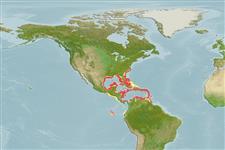Environment: milieu / climate zone / rango de profundidad / distribution range
Ecología
marino batidemersal; rango de profundidad 30 - 400 m (Ref. 5222). Deep-water; 35°N - 3°S, 98°W - 58°W (Ref. 5222)
Western Atlantic: Bermuda, North Carolina (USA), Florida (USA), Gulf of Mexico, Bahamas, Cuba, Yucatan (Mexico), Jamaica, Puerto Rico, the Virgin Islands, and the Leeward islands to Trinidad. Eastern Pacific: Galapagos Islands.
Tamaño / Peso / Age
Madurez: Lm ? range ? - ? cm
Max length : 160 cm TL macho / no sexado; (Ref. 3244); 100.0 cm TL (female); peso máximo publicado: 107.0 kg (Ref. 3244)
Espinas dorsales (total) : 11; Radios blandos dorsales (total) : 14 - 15; Espinas anales: 3; Radios blandos anales: 8 - 9. With 8 or 9 regular vertical darker brown bars on side. The only grouper in the Caribbean with a pattern of regular dark bars (Ref. 26938). Further distinguished by the following characteristics: head and body buff; blackish brown pelvic fins; prominent blackish brown maxillary streak on the cheek along upper edge of the maxilla; depth of body contained 2.4-2.9 times in SL; head length 2.3-2.5 times in SL; convex interorbital area; rounded preopercle angle, with enlarged serrae, 1-2 small serrae at lower edge, just in front of the angle; serrate interopercle and subopercle; posterior nostrils greatly enlarged, diameter is 4 or more times larger than anterior nostrils (Ref. 89707).
Body shape (shape guide): fusiform / normal; Cross section: compressed.
A solitary (Ref. 26340), deep-water species reported from 100-400 m; juveniles sometimes in water as shallow as 30 m. Feeds on fishes, crustaceans, and squids (Ref. 89707). Virtually nothing is known of the age, growth, and reproduction of this species. Marketed fresh.
Life cycle and mating behavior
Madurez | Reproducción | Puesta | Huevos | Fecundidad | Larva
Craig, M.T. and P.A. Hastings, 2007. A molecular phylogeny of the groupers of the subfamily Epinephelinae (Serranidae) with revised classification of the epinephelini. Ichthyol. Res. 54:1-17. (Ref. 83414)
IUCN Red List Status (Ref. 130435: Version 2025-1)
Threat to humans
Harmless
Human uses
Pesquerías: comercial; pesca deportiva: si
Herramientas
Special reports
Download XML
Fuentes de Internet
Estimates based on models
Preferred temperature (Referencia
123201): 16.8 - 26.1, mean 21.7 °C (based on 68 cells).
Phylogenetic diversity index (Referencia
82804): PD
50 = 0.5000 [Uniqueness, from 0.5 = low to 2.0 = high].
Bayesian length-weight: a=0.01349 (0.00621 - 0.02932), b=3.03 (2.86 - 3.20), in cm total length, based on LWR estimates for this Genus-body shape (Ref.
93245).
Nivel trófico (Referencia
69278): 4.6 ±0.0 se; based on diet studies.
Resiliencia (Referencia
120179): Muy bajo, población duplicada en un tiempo mínimo superior a 14 años (Preliminary K or Fecundity.).
Fishing Vulnerability (Ref.
59153): Very high vulnerability (90 of 100).
🛈
Nutrients (Ref.
124155): Calcium = 10.5 [5.1, 24.3] mg/100g; Iron = 0.287 [0.135, 0.621] mg/100g; Protein = 17.8 [15.9, 19.6] %; Omega3 = 0.342 [0.178, 0.655] g/100g; Selenium = 21 [9, 49] μg/100g; VitaminA = 8.34 [1.56, 44.48] μg/100g; Zinc = 0.266 [0.183, 0.408] mg/100g (wet weight);
